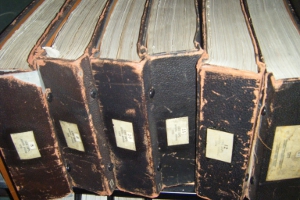The Collection
The Collection's core record series is the Annual Reports of the Land, Lumber, and Mining Departments. This series contains 125 typed and bound volumes that date from 1893 to 1960 and document the operations of iron mines, furnaces, and the exploitation of forest resources. The reports contain detailed comments and descriptions of local management regarding mine, furnace, chemical, land, and lumbering operations, but also detailed quantitative data on the costs of operating mines, furnaces, and logging operations. The reports also provide accounts of the ethnic composition of the workforce, labor union and strike activity, and information on the status of the company's social welfare and safety programs. In essence, the annual reports bring together all the various financial, production, and labor records found in the other disparate components of the collection into one easily accessible source.
The historic maps and plans include over 250 maps and plans that date from 1882 to 1937. The maps describe individual mines and their surrounding communities on the Marquette Range, Minnesota iron ranges, and Wisconsin. Some of these are maps of the surface plant, while others deal with underground workings or details of shaft houses. A considerable number document the timber interests of CCI and other large landholders in the central and western Upper Peninsula. Still other maps relate to the development of the watersheds that CCI tapped in the early twentieth century to produce hydroelectric power for its mining and other related operations. Numerous students, scholars, and the general public have accessed this record series to gather historical information on land use, forestry practices, and environmental depredation.
The third most frequently used record series is the records of Contracts and Jobs administered by CCI's Lumbering Operations from 1915-1943. This record series includes 8 linear feet of 73 individually bound contracts with independent logging companies. At one point, CCI owned and managed nearly one million acres of forest land in the Upper Peninsula. CCI's Land Department maintained a file for each logging contract. This record series includes copies of the contract, maps showing the location of the job, monthly cost sheets, and monthly details of deliveries to other operations and outside parties. The department broke down the cost of deliveries by species and cuts of wood. These records provide insights into how corporate logging operations were carried out in the early twentieth century and detail information about the evolution of forestry practices.

